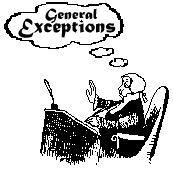TIPS
on Parliamentary
Procedure
According to
Robert's
RULES OF
ORDER

 Some General Exceptions
Some General Exceptions
On the other hand, not all motions require the 6 steps. Your power comes in knowing which motions do and which motions do not require the 6 steps, especially when the chair cannot get away with "If there is no objection ...".
STEP 1. State the Motion:
Some motions are so important that the maker can interrupt the speaker and not even wait to be recognized by the chair! - Question of Privilege, Orders of the Day, Point of Order, Appeal, Parliamentary Inquiry, Point of Information, Division.
STEP 2. Second the Motion:
Some motions do not require a second - Generally, if Robert's Rules of Order allow you to interrupt a speaker, you do not need a second (except Appeal).
STEP 3. Chair Restates the Motion:
The presiding officer may help a verbose person rephrase the motion.
STEP 4. Discuss the Motion:
Some motions may not be debated because the debate would defeat the purpose of the motion - Recess, Orders of the Day, Lay on the Table, Limit or Close Debate, Division of the Assembly, Division of the Question.
STEP 5. Vote on the Motion:
Some motions are made and passed without voting - Question of Privilege, Orders of the Day, Point of Order, Division.
STEP 6. Announce Result of Vote:
No exceptions here. The result of the voting must always be announced.
![]()
parliam@roberts-rules.com a member of
National Association of Parliamentarians and
American Institute of Parliamentarians Created by Cuesta Web Designs; Sacramento, California